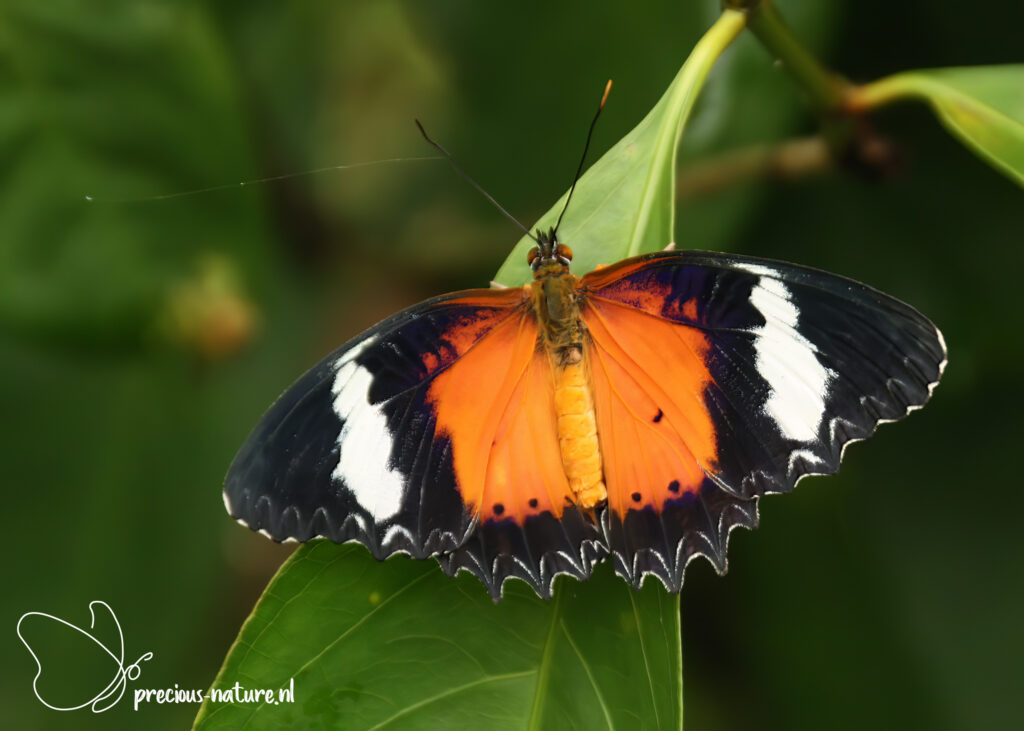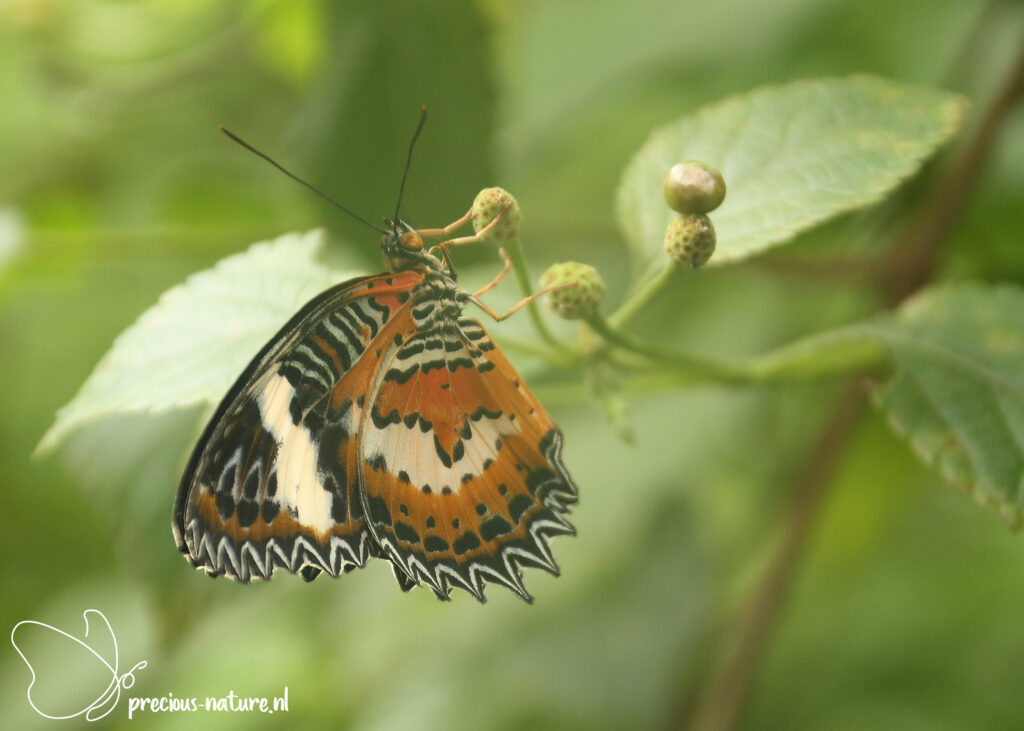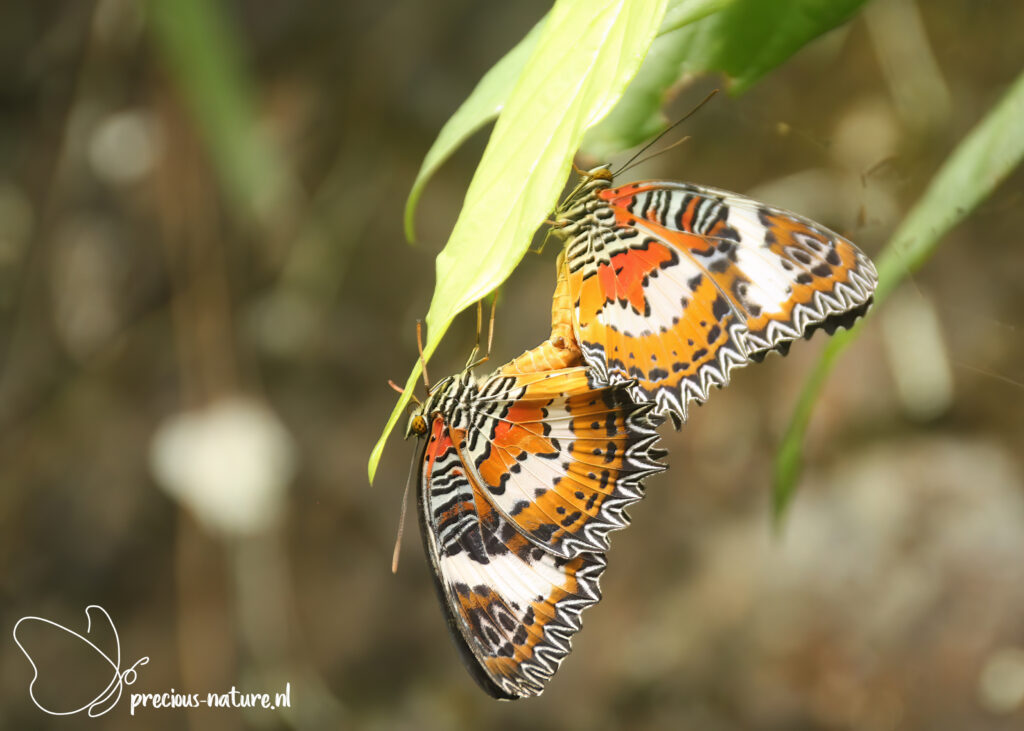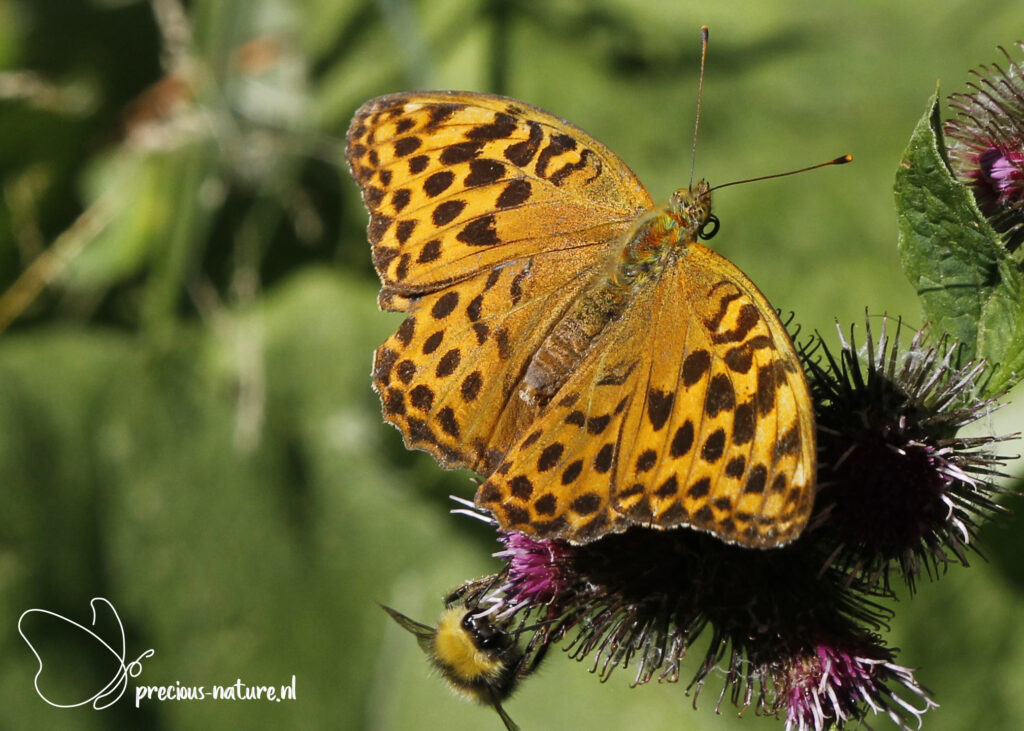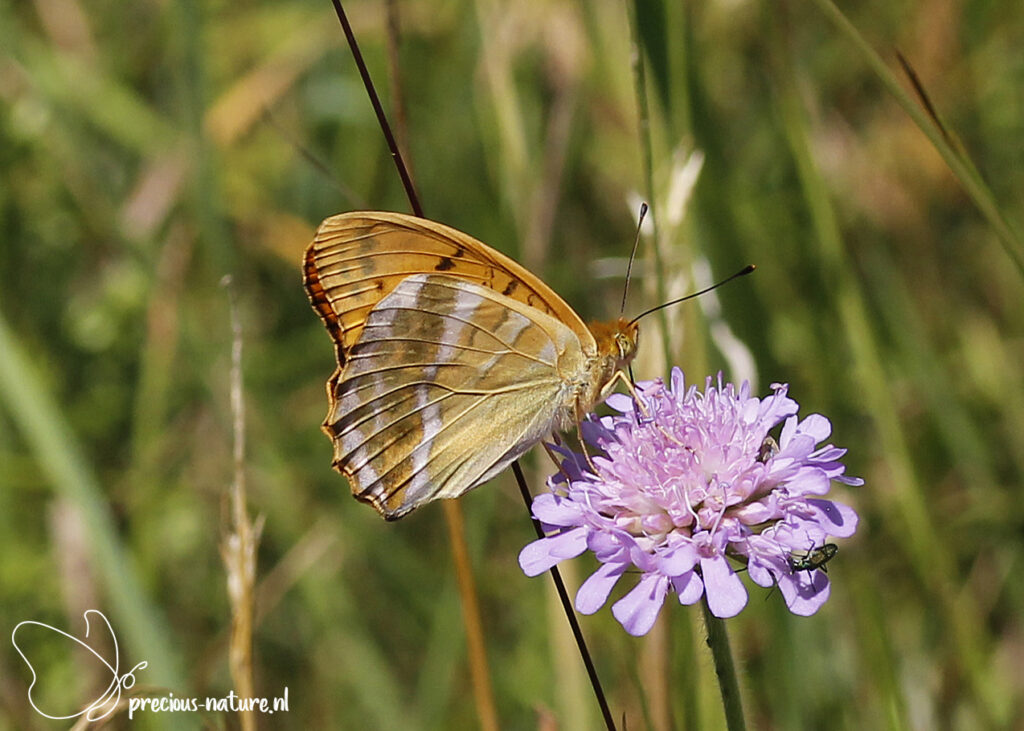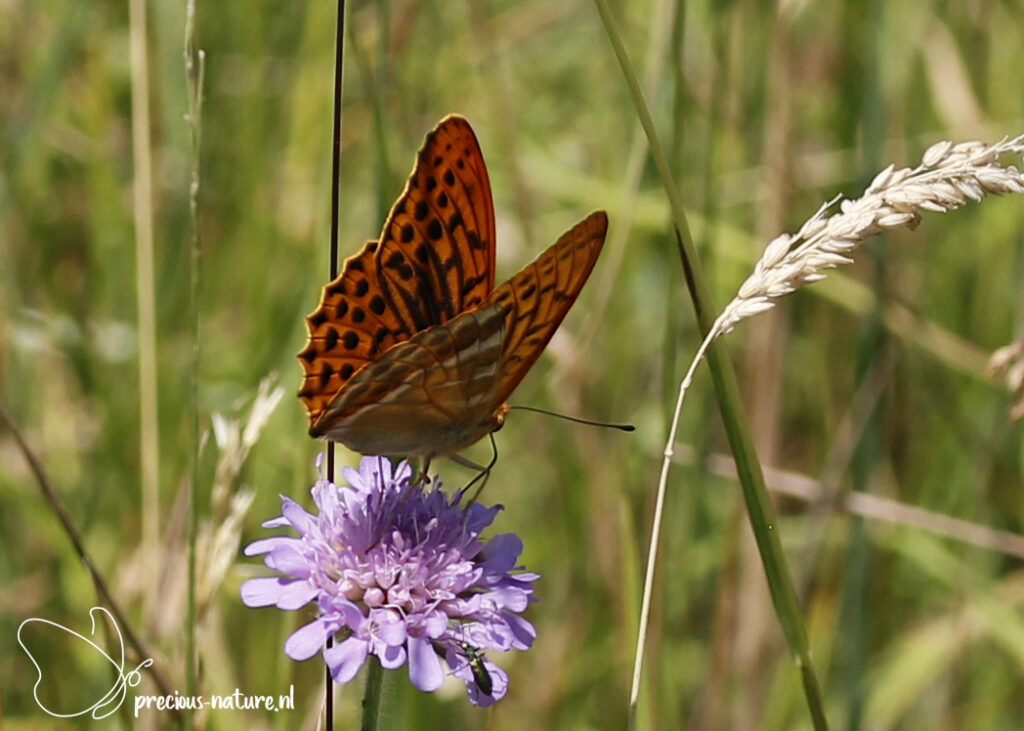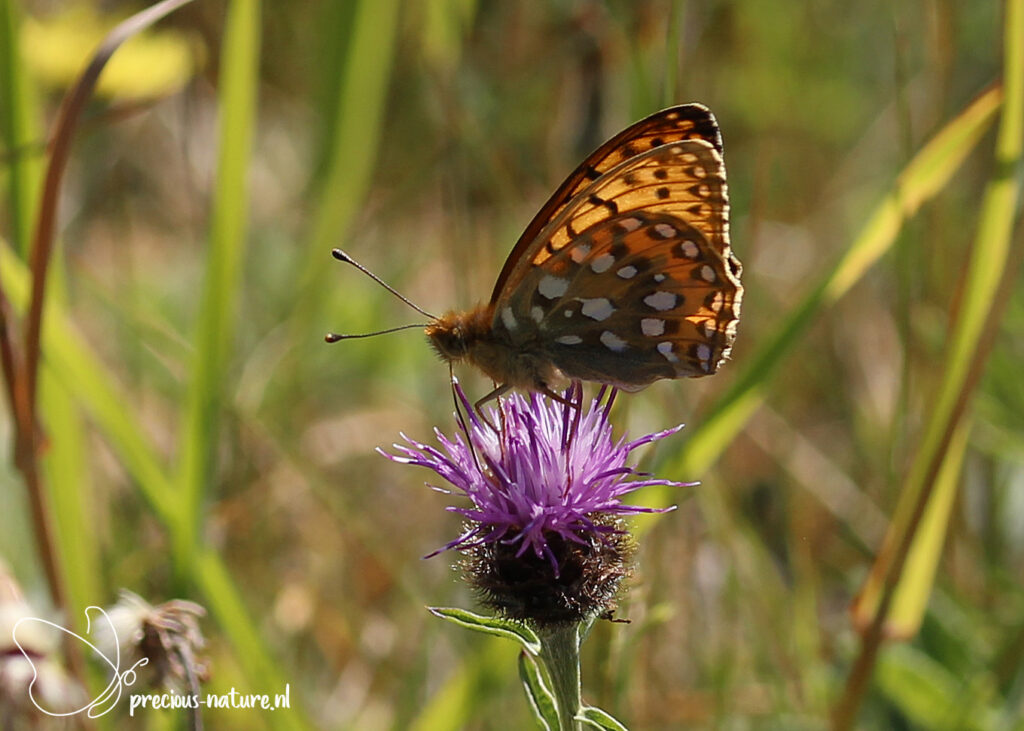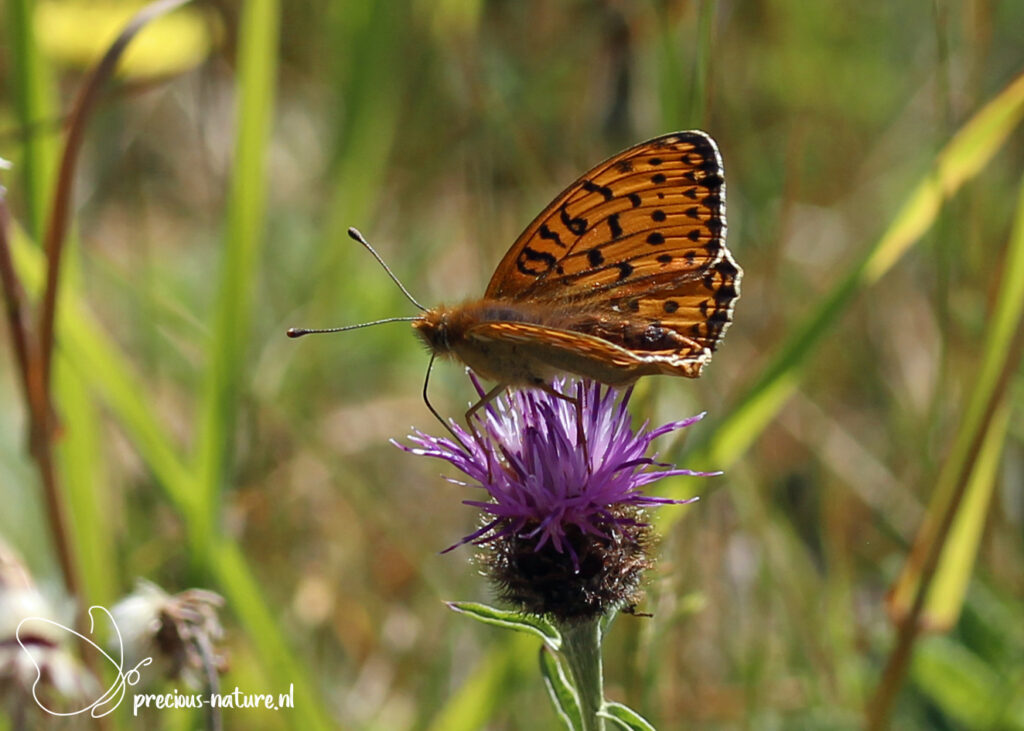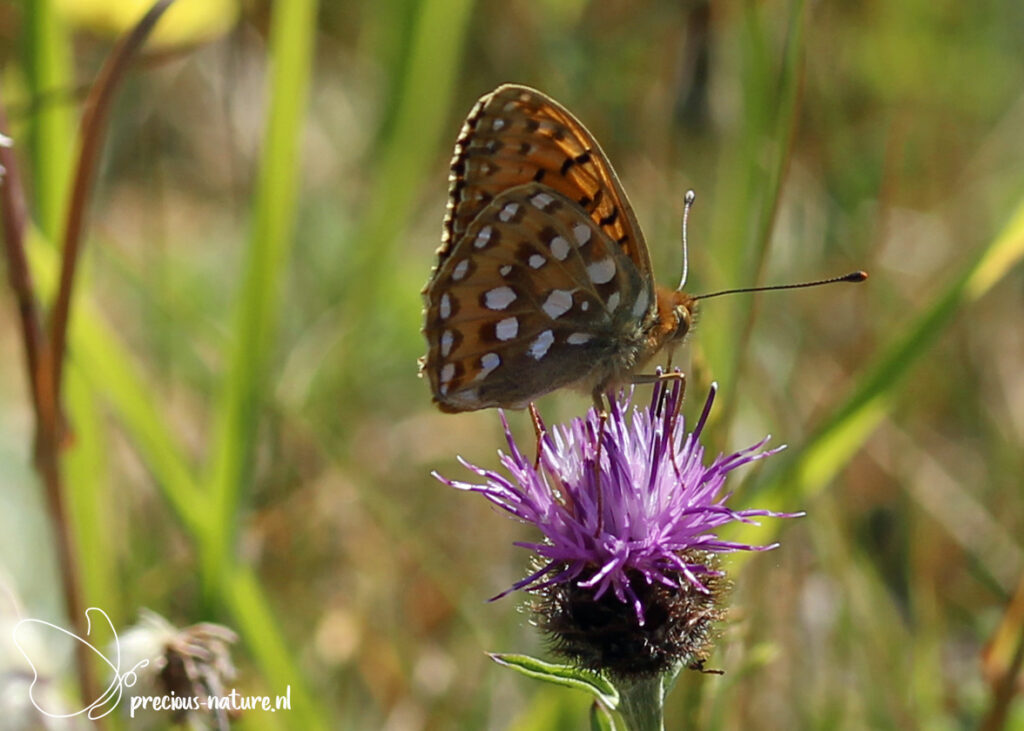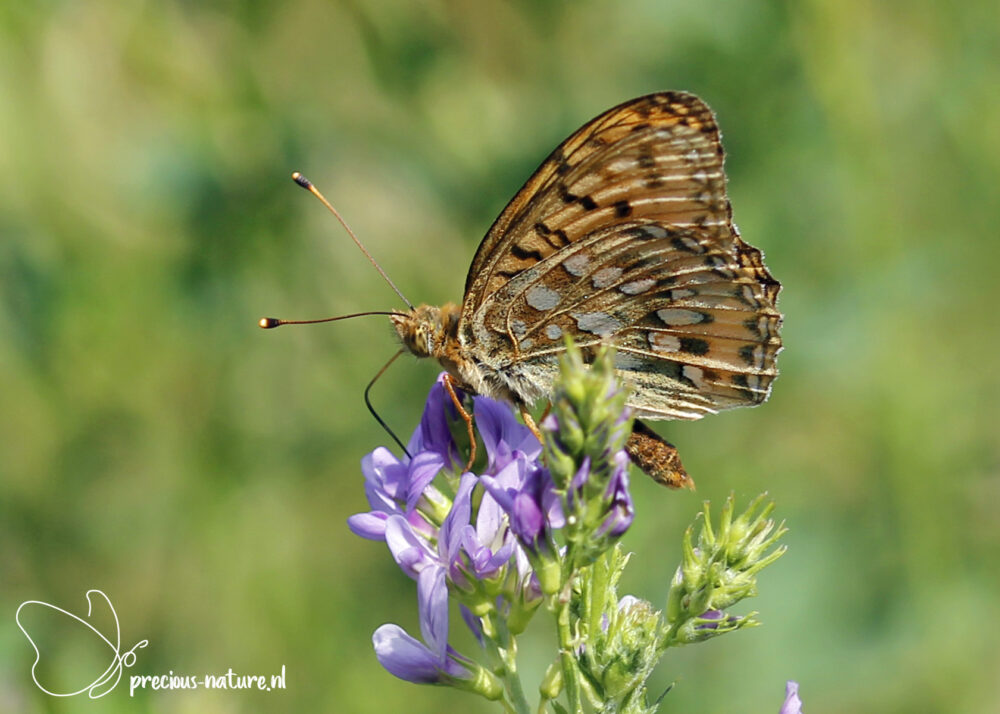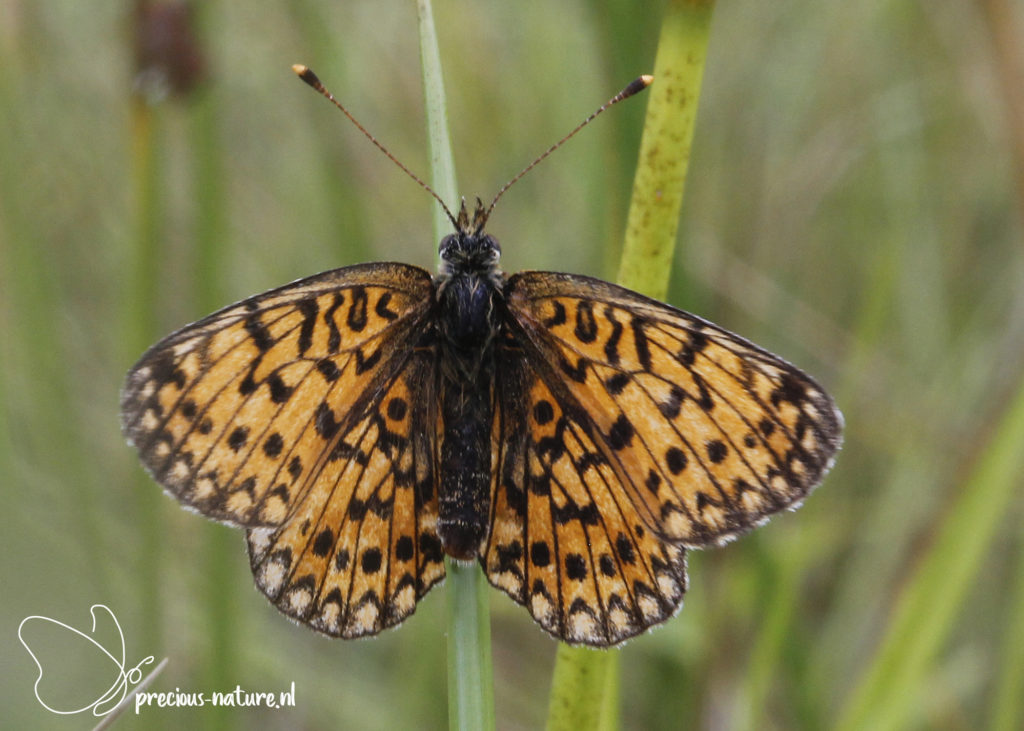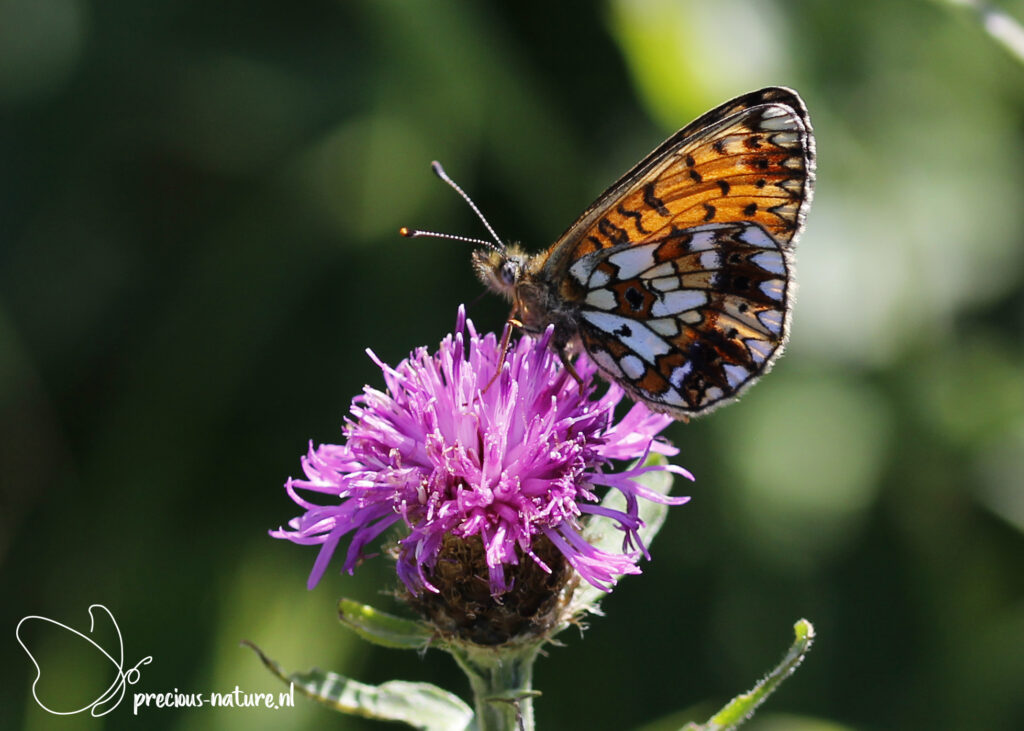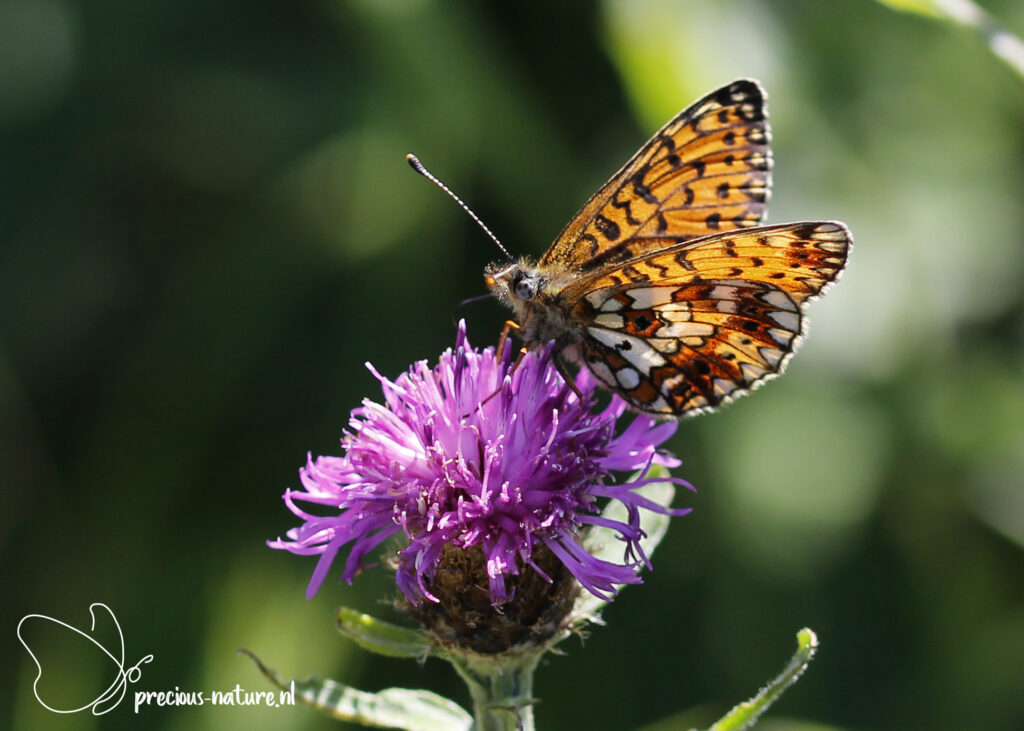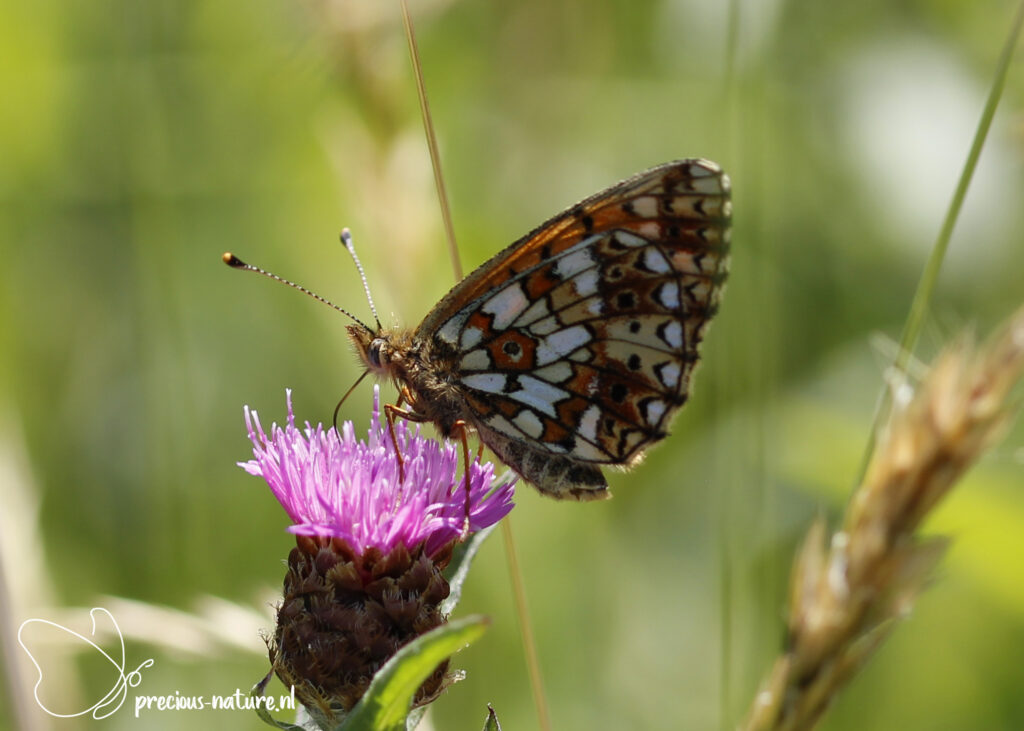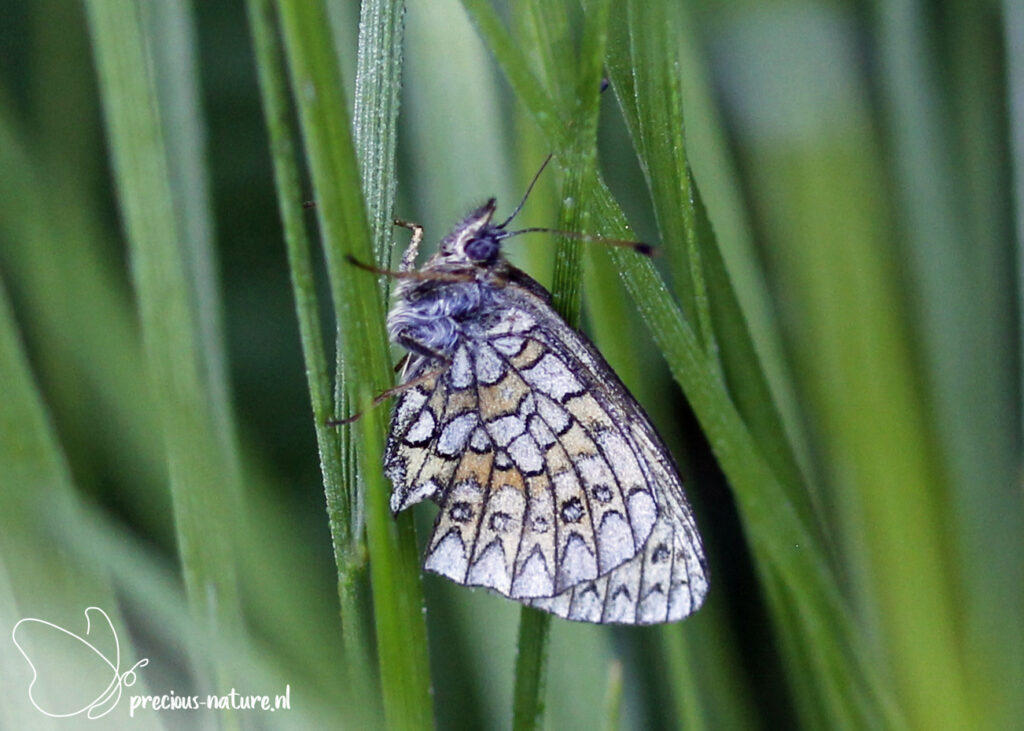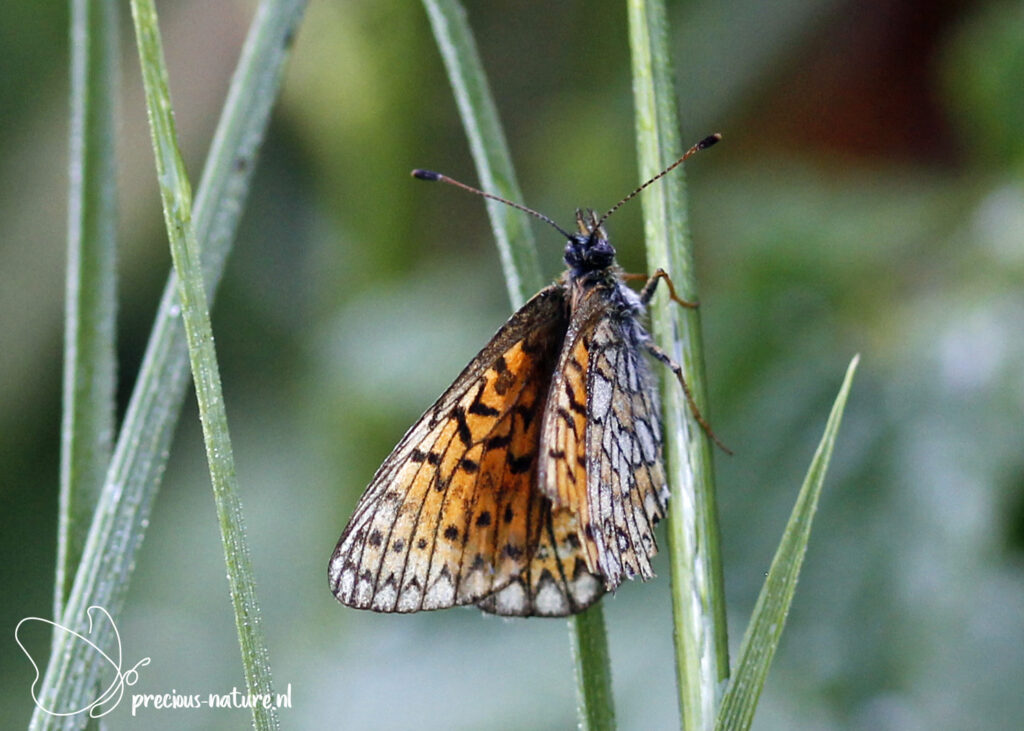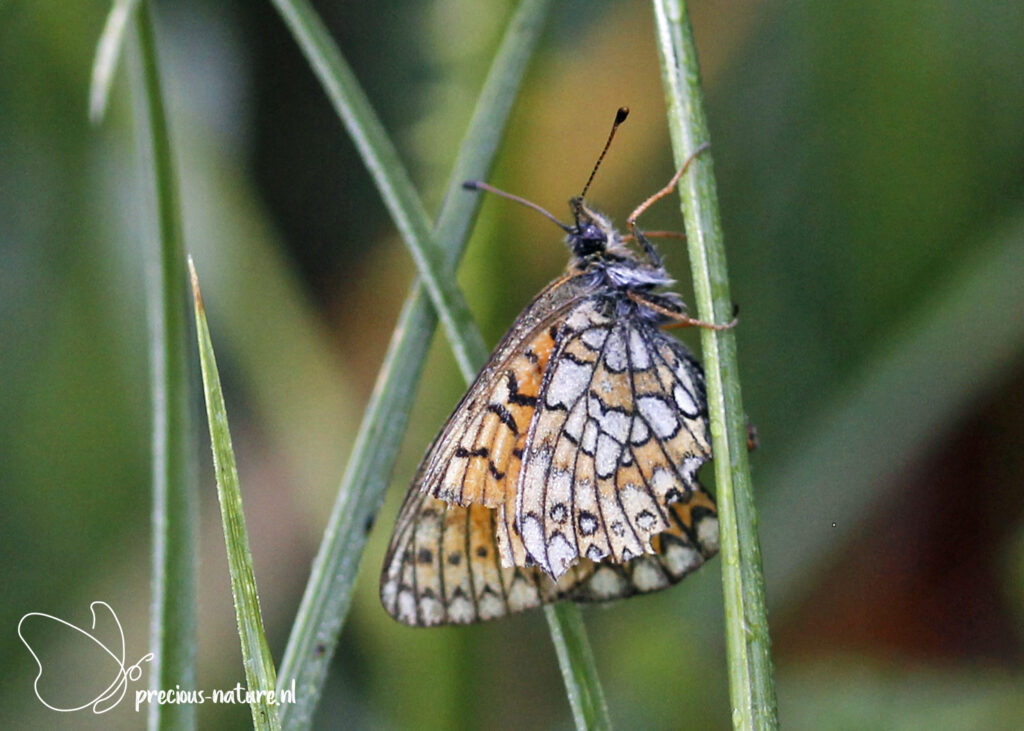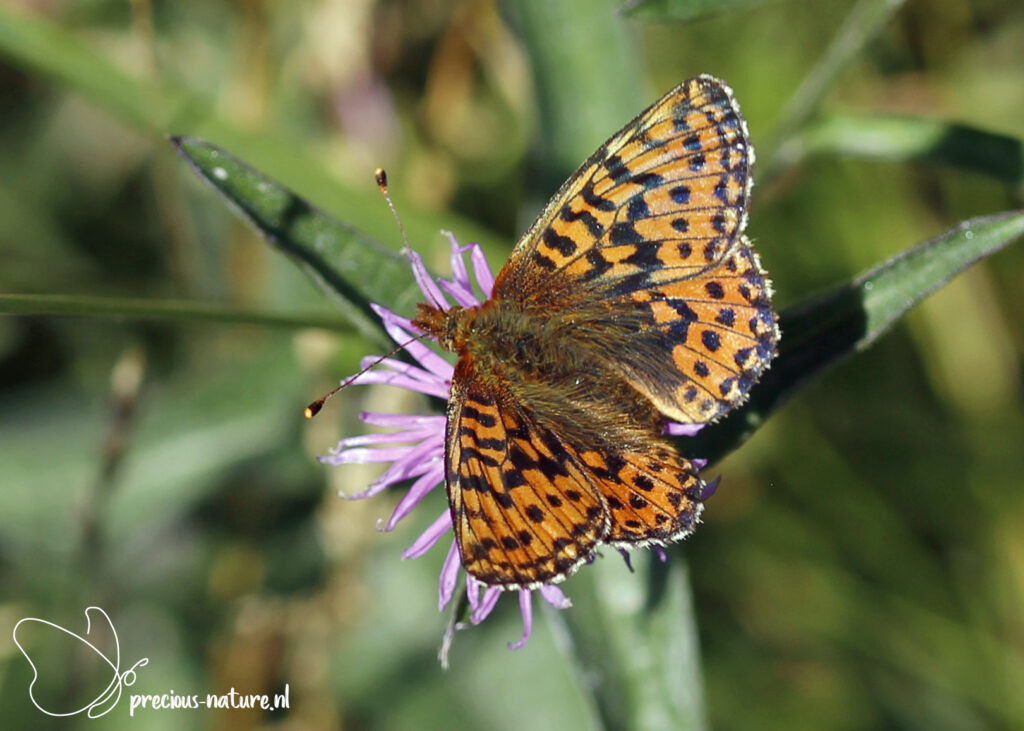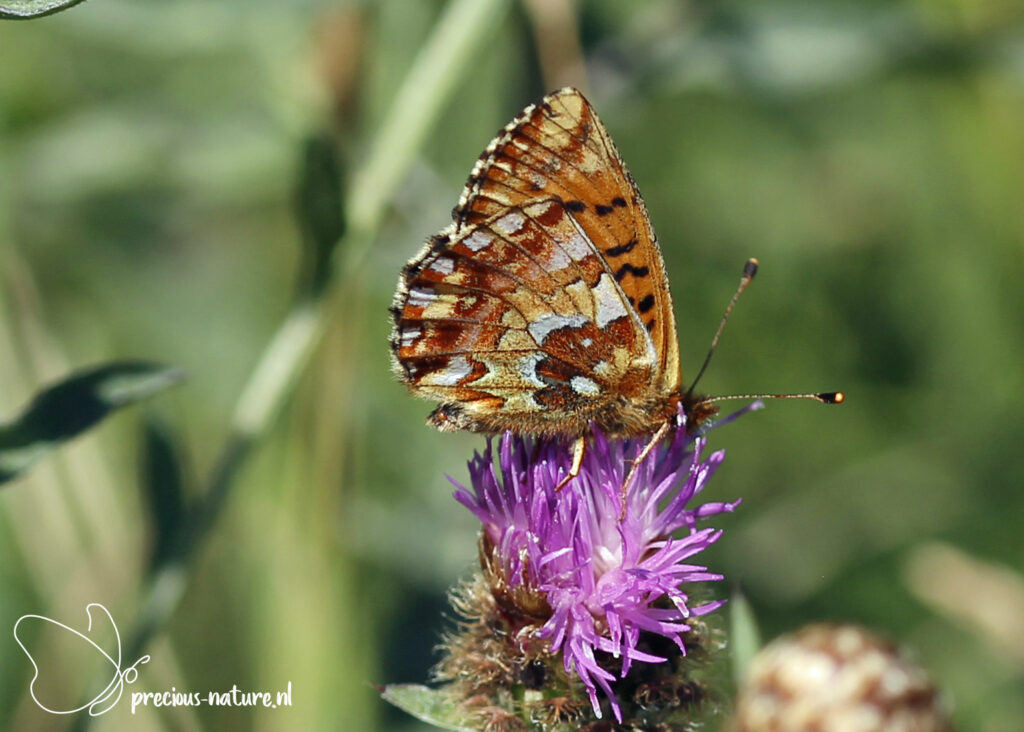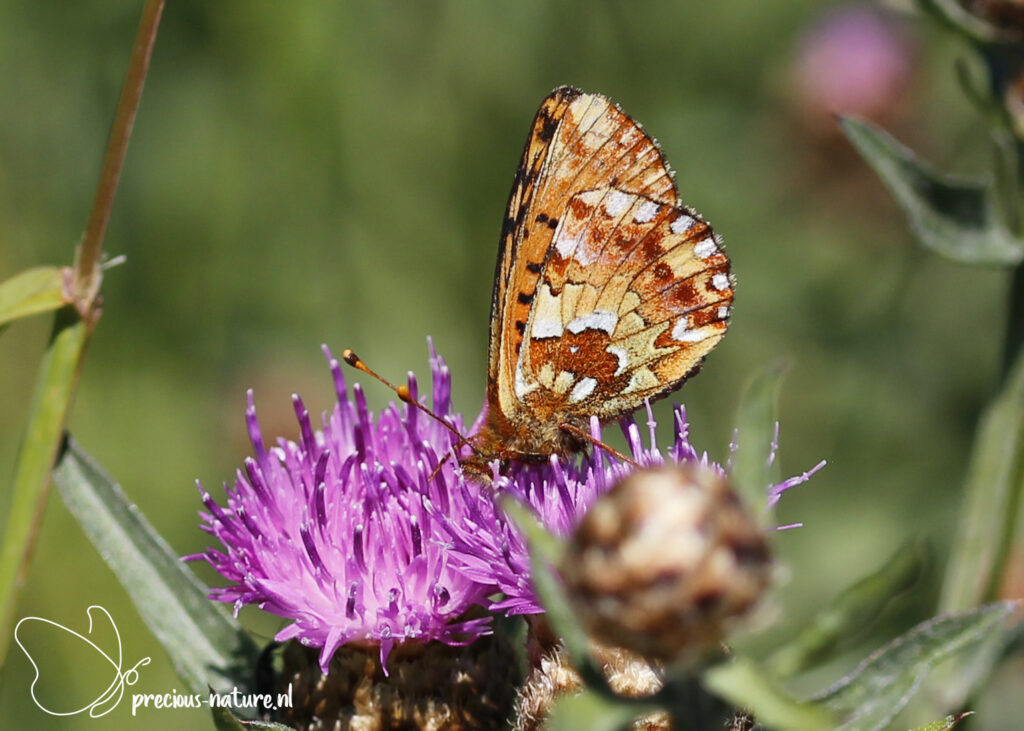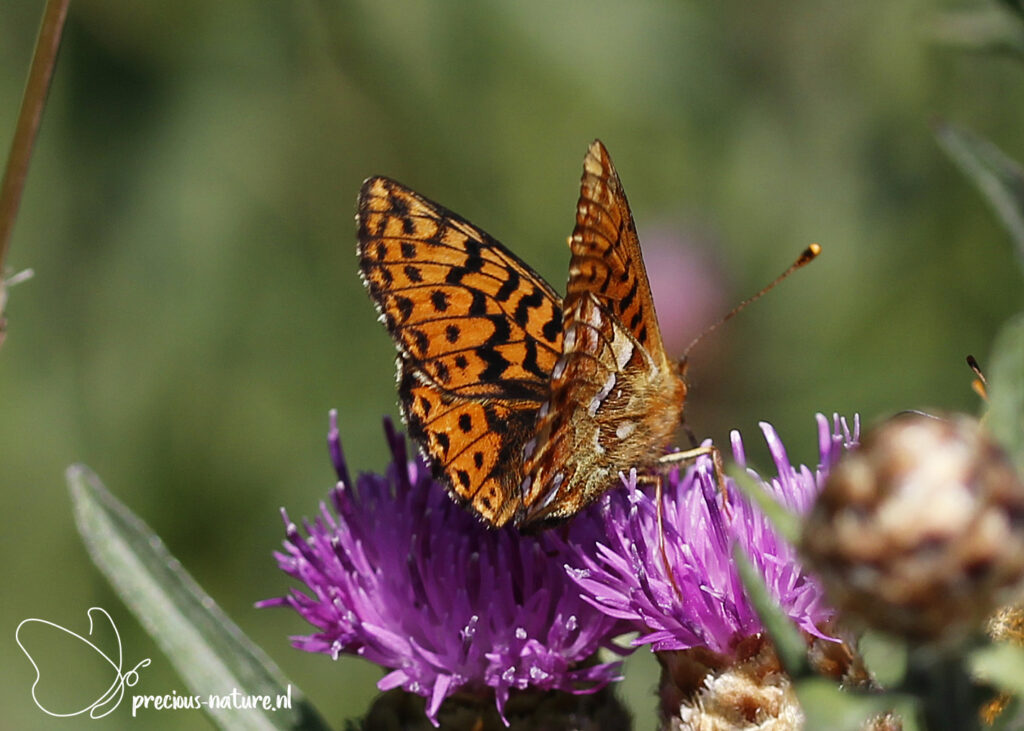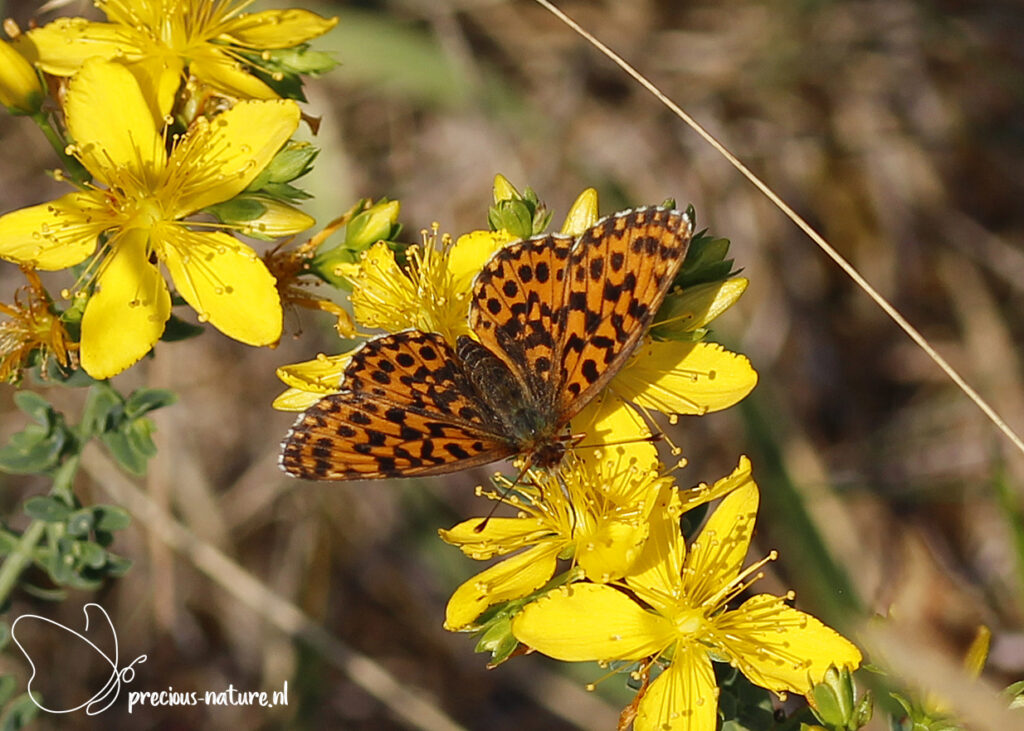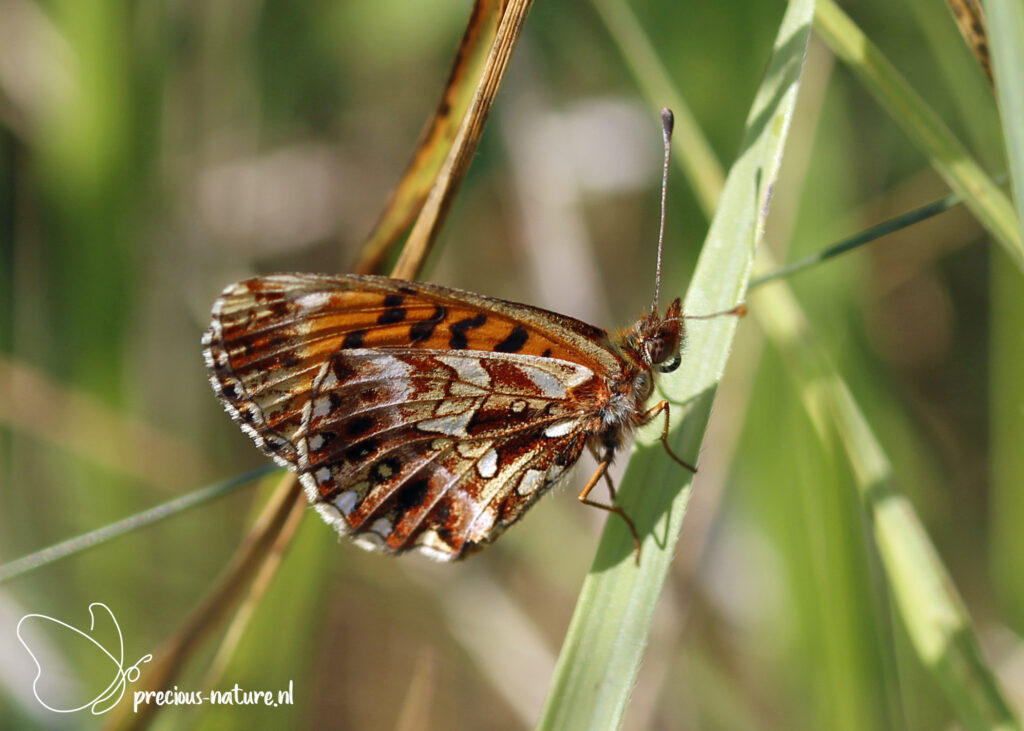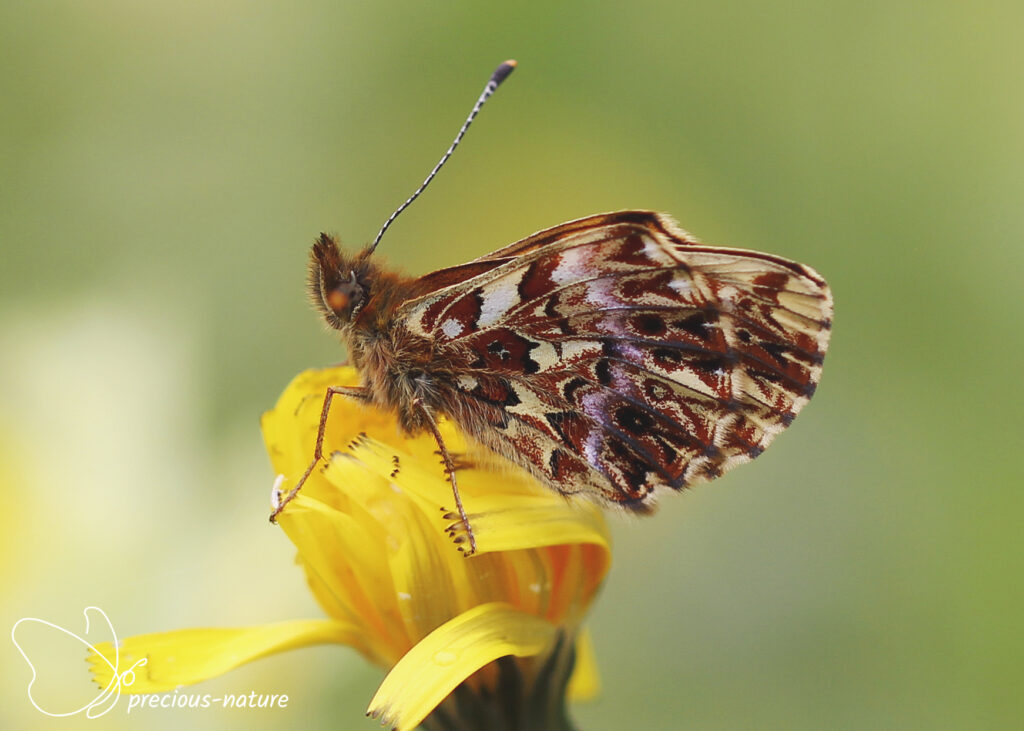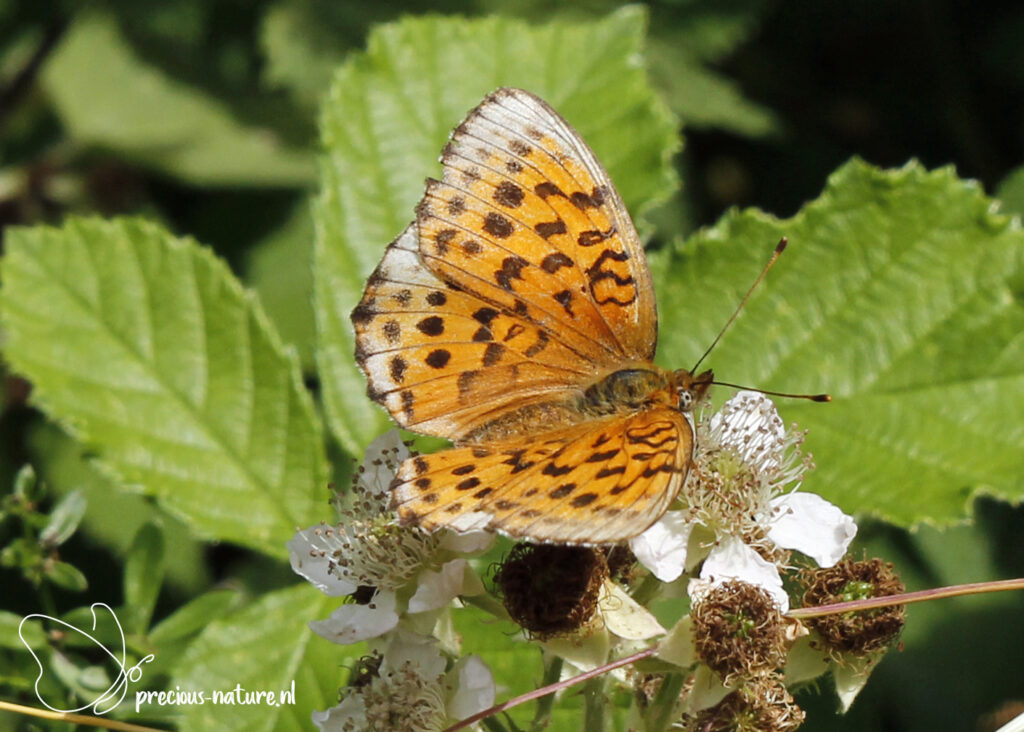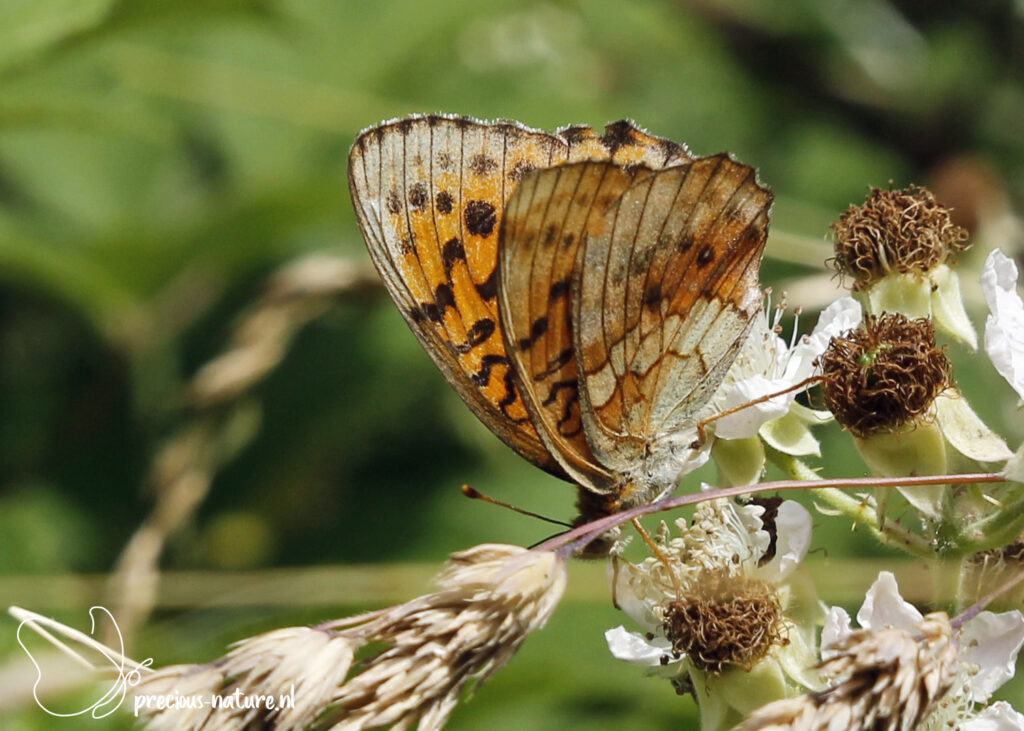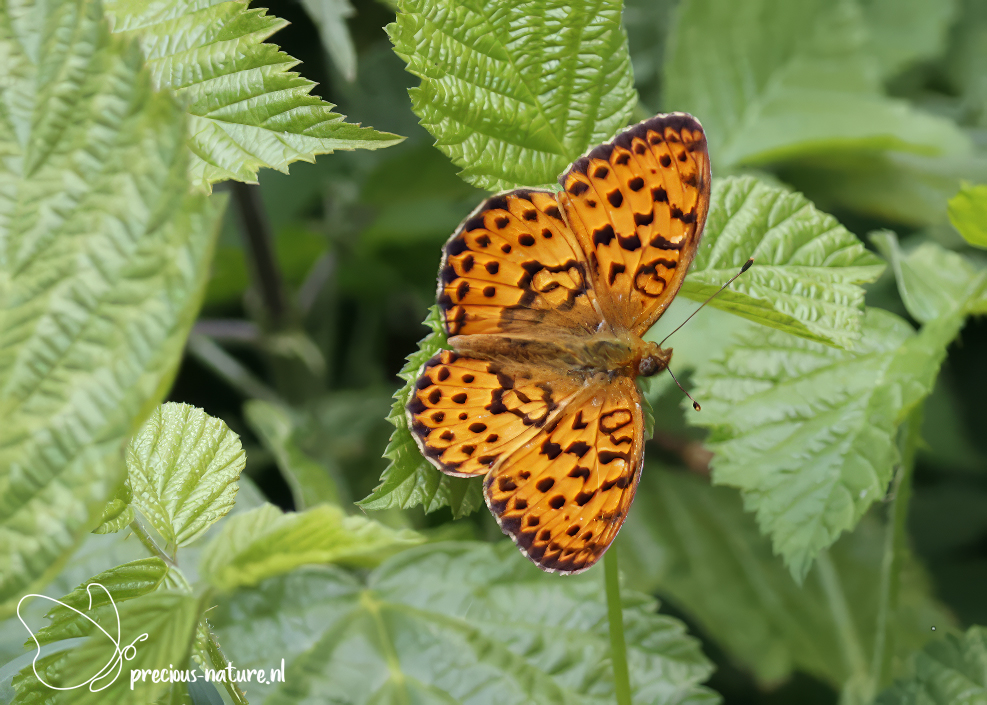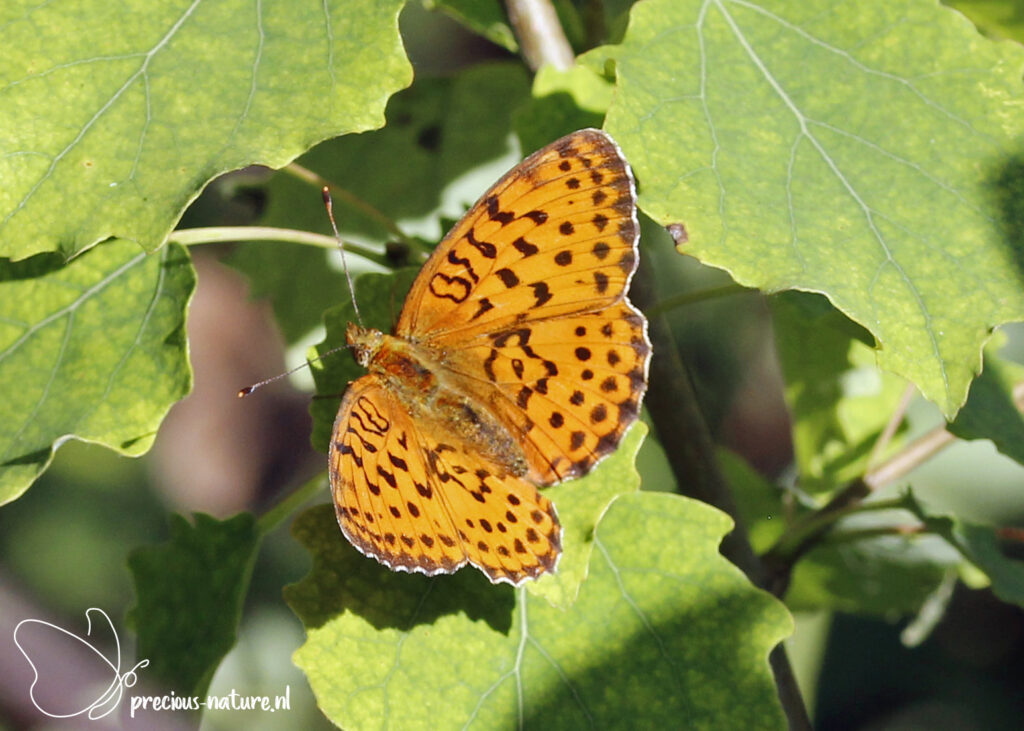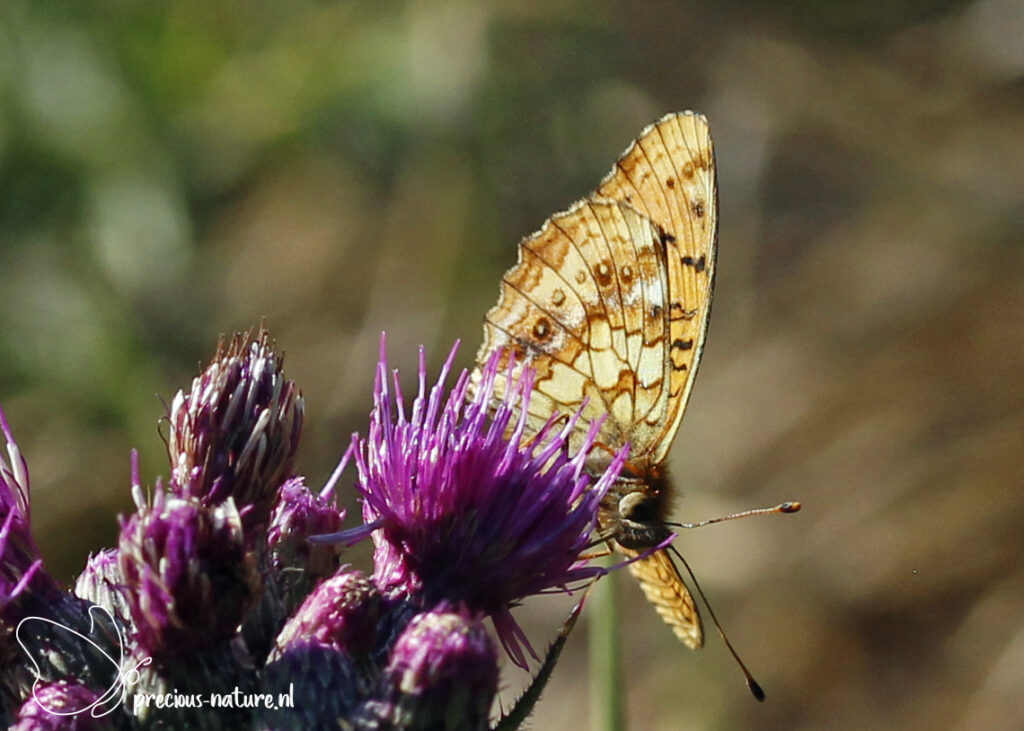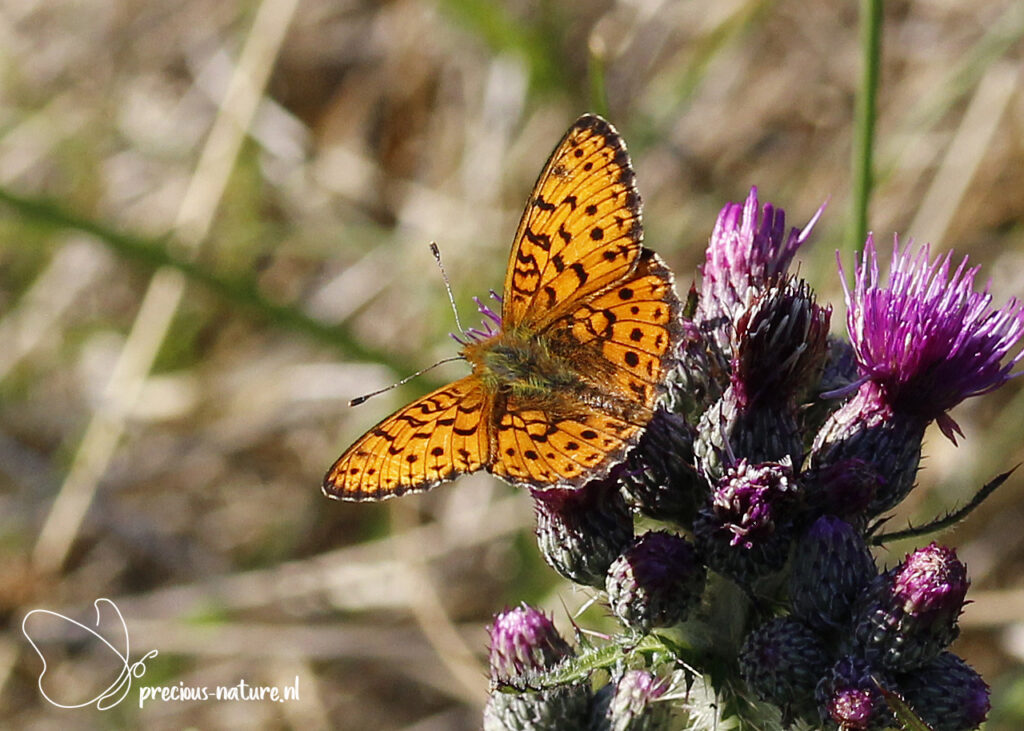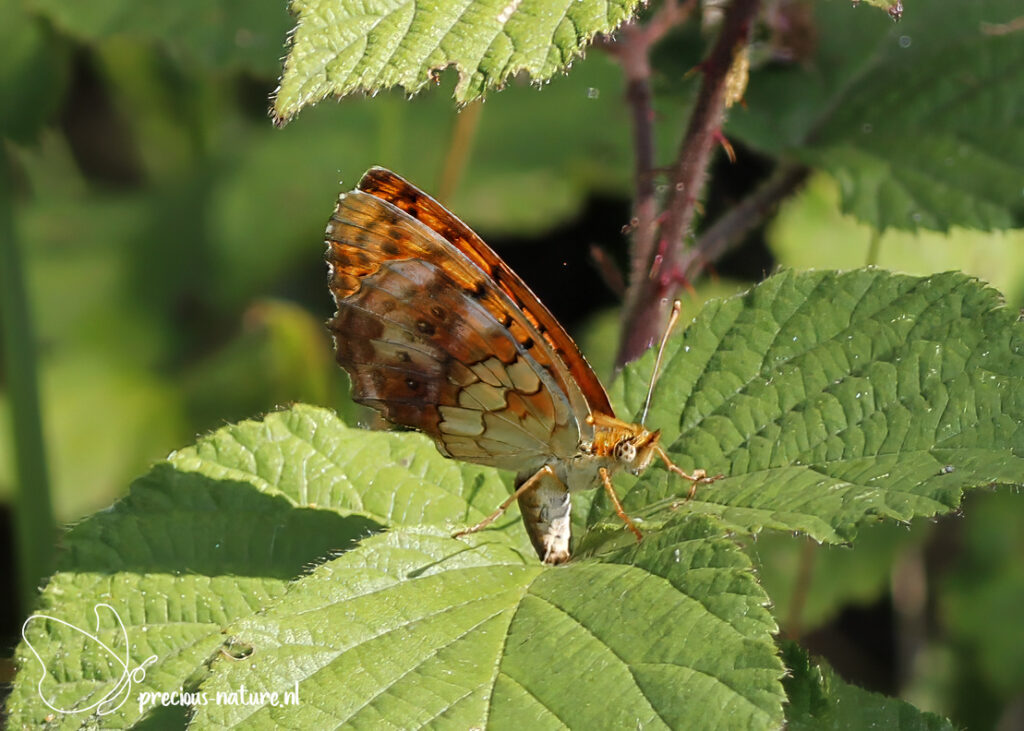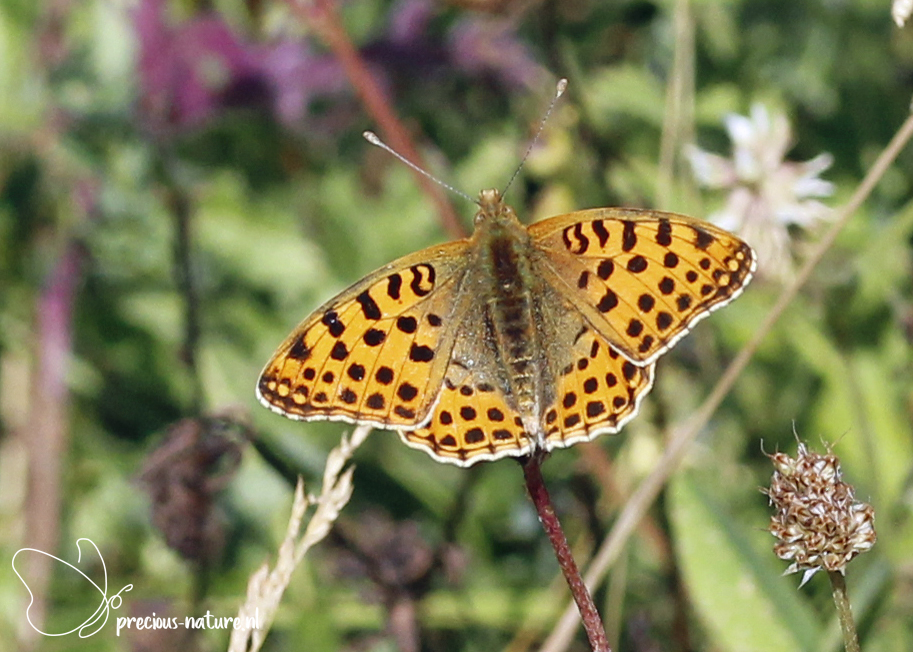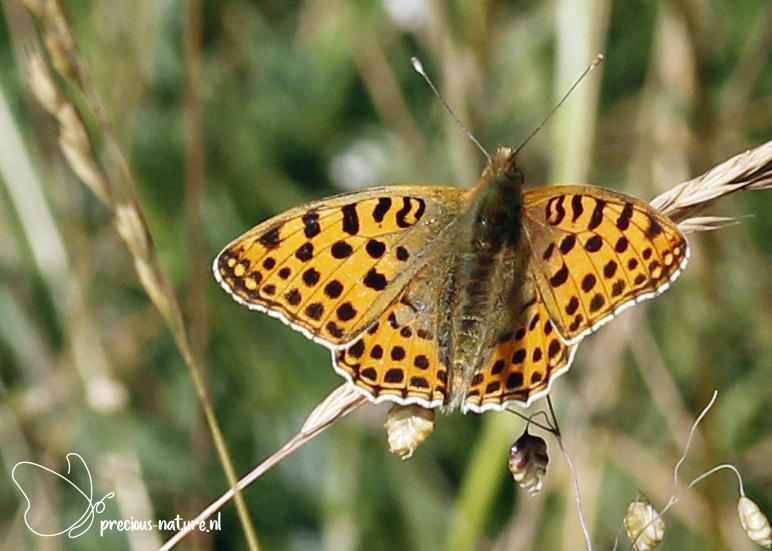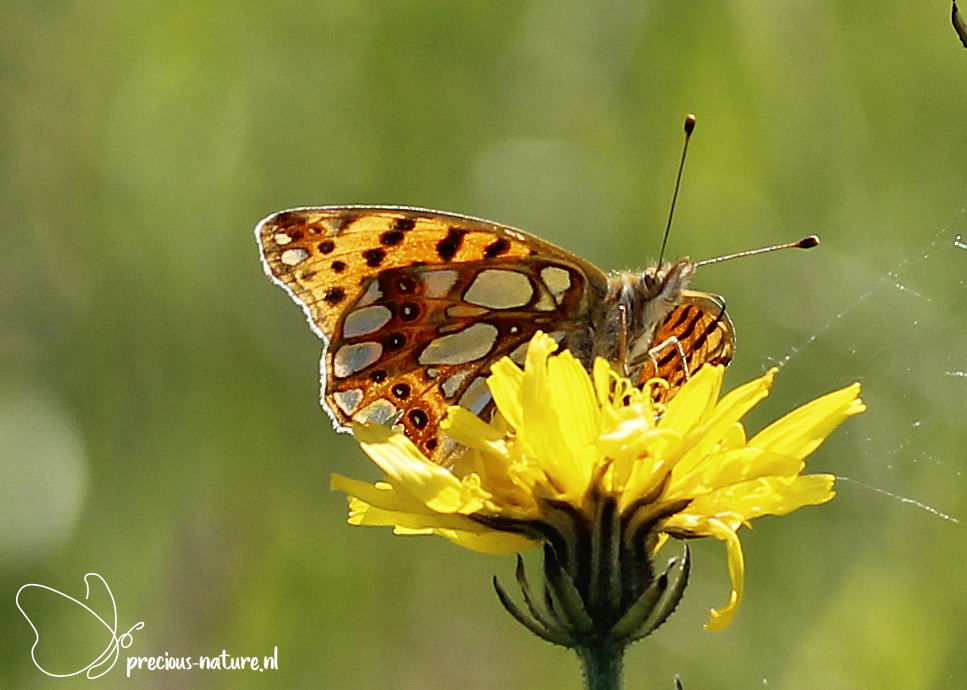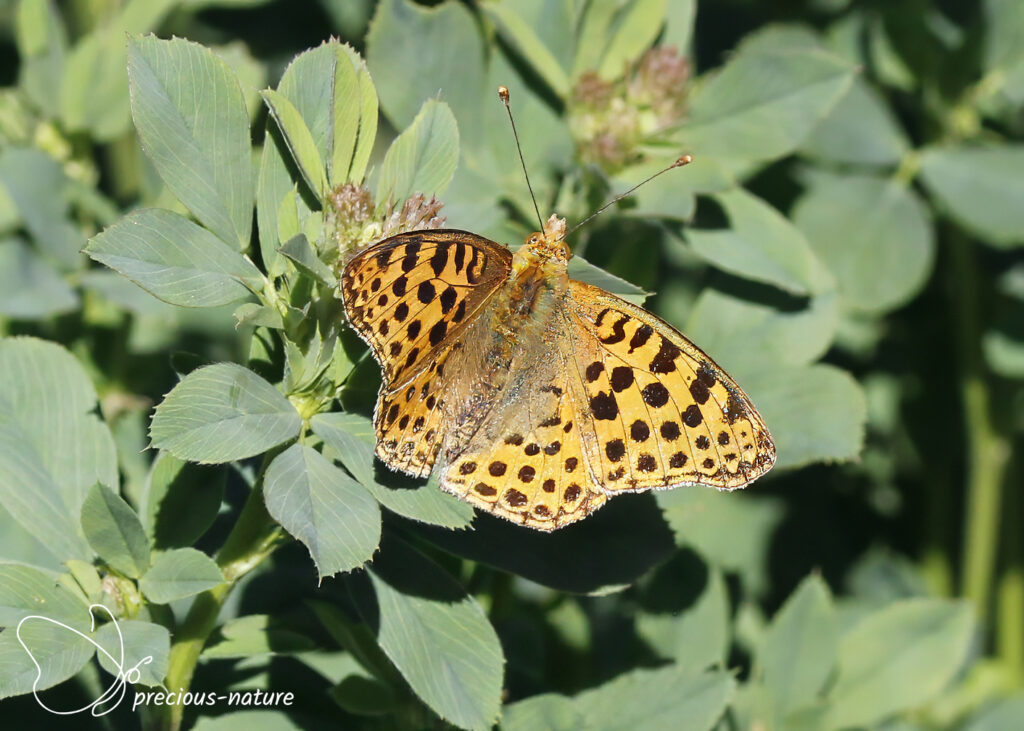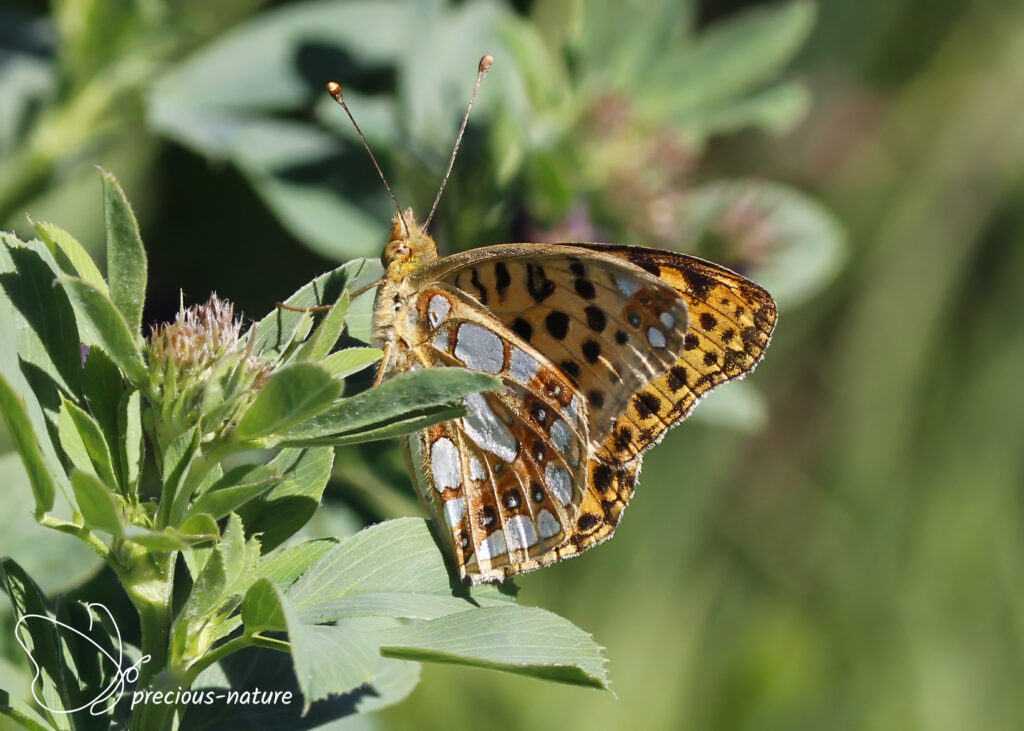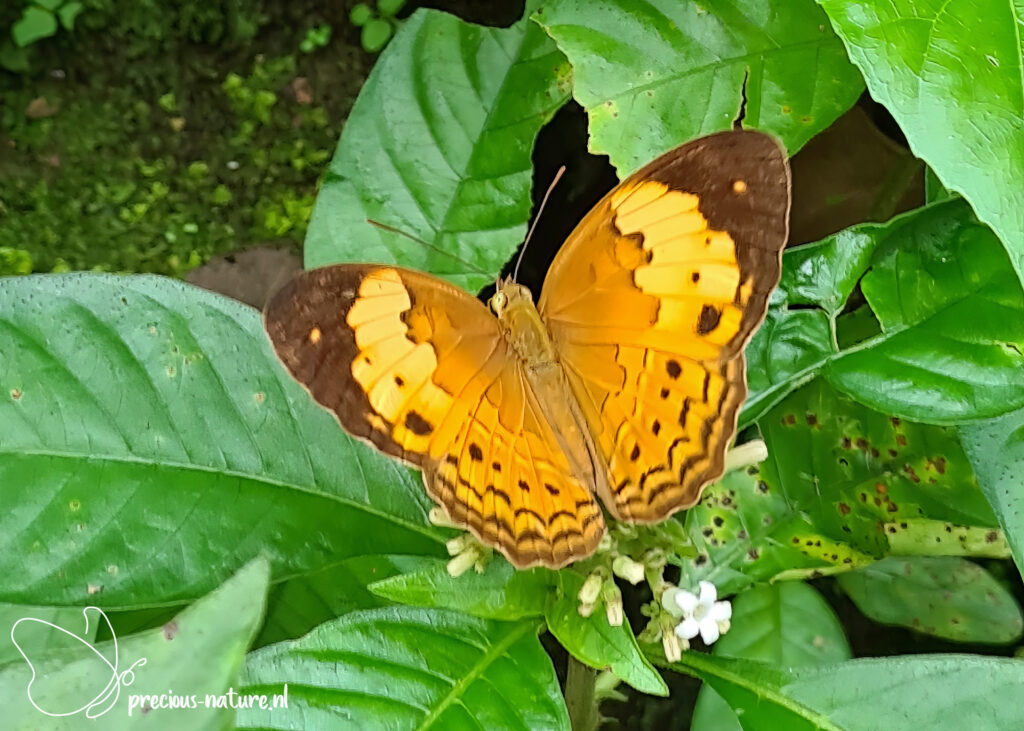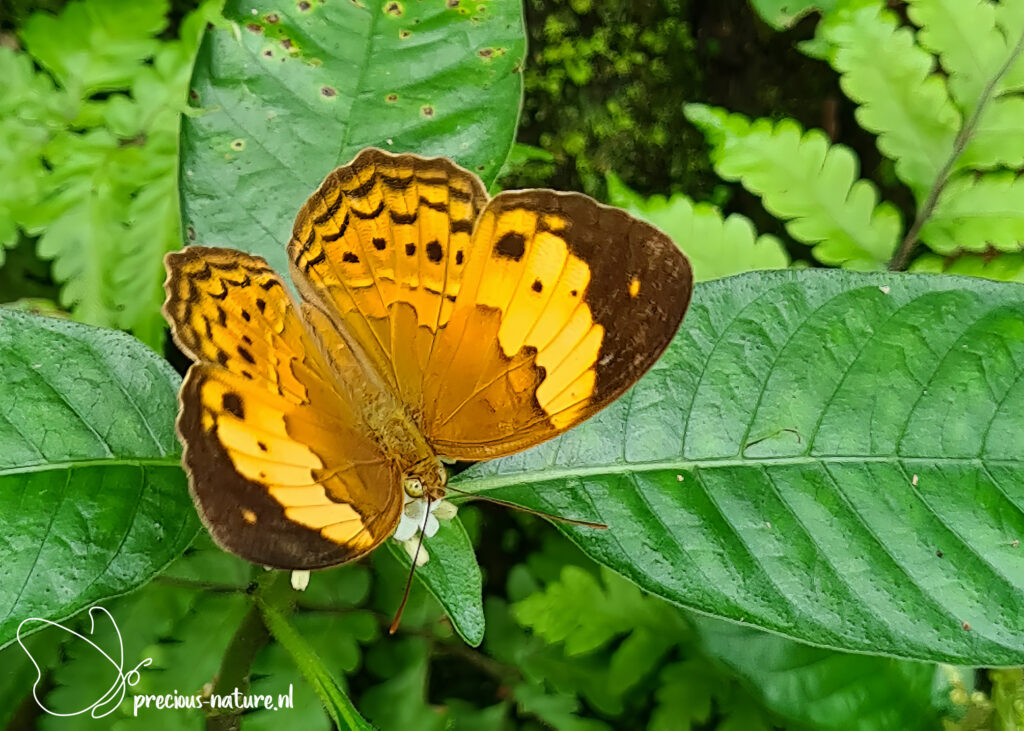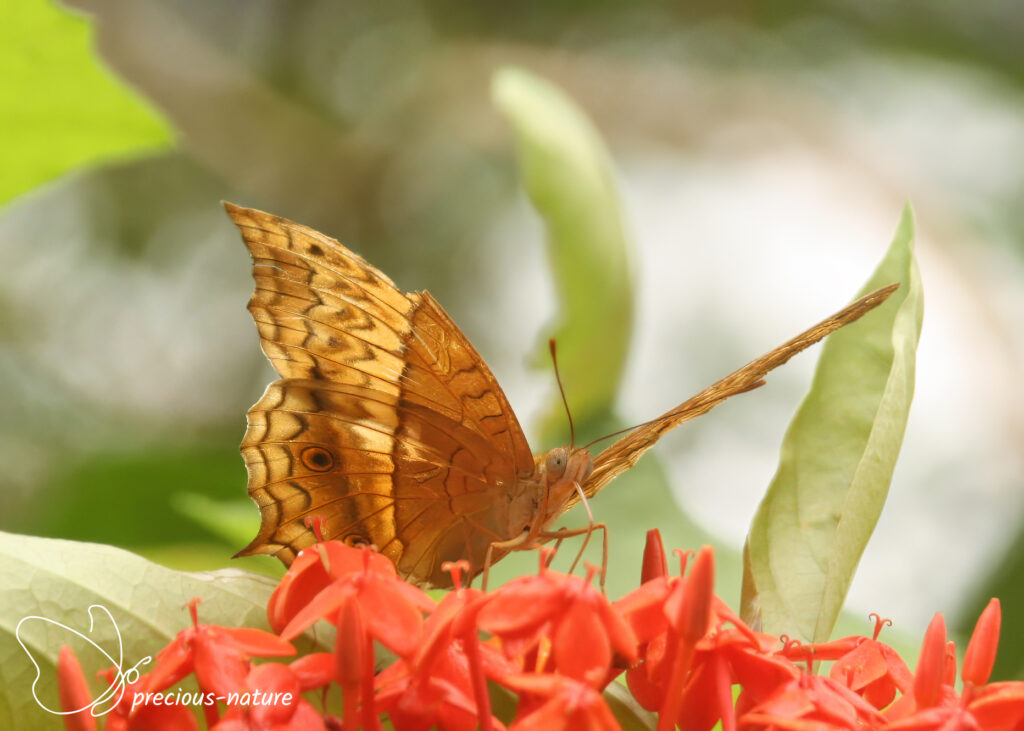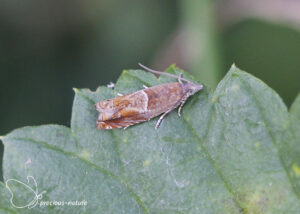The medium to large fritillaries, the Longwings (Heliconiinae), range in size from 60-100 mm and are protected by bitter body fluids. This makes them inedible for predators. The predators are warned by the beautiful colour patterns, often combinations of black with red, orange, yellow, and blue. Due to the enormous variability within a species, these butterflies are sometimes challenging to identify. The Longwings are a subfamily of the Brush-footed Butterflies (Nymphalidae).
Tribe: Acraeini
Genus: Cethosia
Lacewing Butterfly – 2022 (INA)
(NCBI-index: 127317)
Sometimes, finding a Dutch name when discovering butterflies abroad takes a while. This also applies to the Lacewing Butterfly (Cethosia hypsea) I found in Bali. This butterfly is bright orange-red above with broad black margins. With this bright orange, they warn predators that they are poisonous. The wings are scalloped, giving the hindwings an almost sawtooth-like appearance. The undersides are orange-red with white bands and are mottled with black, forming an intricate pattern. Females and males can be distinguished by the wing colour pattern on the dorsal (top) side. The dorsal side of the male has a black base colour pattern with white spots and bright orange, while females have a black base colour pattern with white and red spots. From the ventral direction, both males and females have the same colour pattern, combining bright brown, white, red-orange, and black spots. In the ventral part, the V-shaped pattern on the edge of the wing also looks very clear, as shown by the black and white scales. In addition to the colour pattern, males and females can be distinguished by the wingspan; males have a smaller wingspan than females. The wingspan is 60-80 mm. Host plant: Prickly Lantana and Snakeweed. Dutch name: Luipaardvlinder. Frisian name: –
Tribe: Argynnini
Genus: Argynnis
Silver-washed Fritillary – 2013 (FR)
(NCBI-index: 171802)
The Silver-washed fritillary (Argynnis paphia) has disappeared from the Netherlands as a butterfly since 1980. Occasionally, he was still found as a migrant from France, where I found this fritillary. The Silver-washed Fritillary was found in Limburg (Netherlands) in 2005, and after 10 years, this butterfly may be appointed as a resident butterfly again. The male is best recognised. The top of the orange forewing shows three distinct black scent stripes. Furthermore, the top is covered with a black spot pattern. The underside of the forewing is orange-yellow, and the hindwing is greenish with silvery stripes that are widest in the female. The wingspan is 72-76 mm, and the flight period is from June to September for one generation. Host plant: Common Dog-violet, Thistle. Dutch name: Keizersmantel. Frisian name: Keizersmantel.
Flying period:

Tribe: Argynnini
Genus: Argynnis
Dark Green Fritillary – 2023 (BE)
(NCBI-index: 405010)
A powerful butterfly that you often see flying quickly over open grassland with violets and rough places. The Dark Green Fritillary (Argynnis aglaja) is distinguished from its peers by the green colour on the hindwing’s underside and the zoom field’s light orange band. Furthermore, numerous large, silver-coloured spots are on the entire wing, whereas the ones along the wing edge have a green triangular spot on the inside. The top of the fore and hind wings are orange with black spots and dots. Similar species are the High Brown Fritillary (Fabriciana adippe) and the Niobe Fritillary (Fabriciana niobe), both of which have small white spots on the underside of the hindwing with a brown-red edge, and the Silver-washed Fritillary (Argynnis paphia), which has no white spots on the underside of the hindwing. The flight period is one generation from June to the end of August, and the wingspan is 45-58 mm. Host plant: rough violet, tricolour violet, dog violet, dune violet. Dutch name: Grote parelmoervlinder. Frisian name: Grutte parlemoerflinter.
Flying period:

Tribe: Argynnini
Genus: Bolaria
Small Pearl-bordered Fritillary – 2018 (NL)
(NCBI-index: 191398)
The Small Pearl-bordered Fritillary (Boloria selene) is a rare and endangered species in the Netherlands. It still occurs in peat areas in the North. The adults fly close to the ground, stopping frequently to take nectar from flowers such as Bramble and thistles. The top of the wings is orange with a row of black dots near the costa and more prominent spots spread over the rest of the wing. The termen has lighter orange to white spots with a black V-shape inward. The bottom is covered with light cells, some of which are white. Several cells form a crescent moon with some imagination. The black dot in the orange central cell on the underside of the hindwing is the hallmark that best describes the Silver-meadow Fritillary. The wingspan is 41-44 mm, and the flight period spans from May to September, encompassing one or two generations. Host plant: Common Dog-violet, Marsh Violet. Dutch name: Zilveren maan. Frisian name: Sulveren moanne.
Flying period:

Tribe: Argynnini
Genus: Boloria
Bog Fritillary – 2023 (BE)
(NCBI-index: 405022)
During my trip to Germany and Belgium, I saw many new-to-me fritillary species, including the easy-to-recognise Bog Fritillary (Boloria eunomia). The best feature to recognise this butterfly is the complete row of black eyespots with a yellowish-white centre, which gives it its Dutch name. You also see two orange bands in the root and midfield. The top of the wings is orange with black spots in the zoom field and several black stripes closer to the wing root. The wing edges are slightly darker, with small, lighter triangles trimmed with dark, thin lines. The flight period spans one generation, from late May to mid-July, and the wingspan ranges from 28 to 40 mm. Host plant: Alpine Smartweed and violets. Dutch name: Ringoogparelmoervlinder. Frisian name: –
Flying period:
![]()
Tribe: Argynnini
Genus: Boloria
Cranberry Fritillary – 2023 (BE)
(NCBI-index: 405021)
In the Netherlands, this butterfly is endangered and is now rarely found. Only a few observations are known in Drenthe. However, I encountered the Cranberry Fritillary (Boloria aquilionaris) in significantly larger numbers in Belgium. The tops of the wings are orange with black spots and dots. One of the better features to distinguish this fritillary butterfly from several related species is the two opposing V-shaped spots in cell 1B on the top of the forewing. The ground colour of the underside of the hindwing is reddish brown with a purple tinge, which gives a flamed impression of purplish, silvery, and yellow spots. The black spots on the underside of the hindwing are pretty blurry. The hindwing has a straight leading edge that protrudes conspicuously behind the forewing in resting butterflies. The flight period is one generation from mid-June to August, and the wingspan is 34-36 mm. Host plant: Common Cranberry. Dutch name: Veenbesparelmoervlinder. Frisian name: Feanbeiparlemoerflinter.
Flying period:

Tribe: Argynnini
Genus: Boloria
Weaver’s Fritillary – 2023 (BE)
(NCBI-index: 596532)
The Weaver’s Fritillary (Boloria dia) is uncommon in the Netherlands. I spotted my first copy in the Belgian Ardennes. This fritillary cannot be clearly distinguished at the top from the Small Pearl-bordered Fritillary (Boloria selene), the Pearl-bordered Fritillary (Boloria euphrosyne) and the Cranberry Fritillary (Boloria aquilionaris). The difference is in the underside of the wings. The Small Pearl-bordered Fritillary and Pearl-bordered Fritillary do not have purple spots on the underside of the hindwing. In the Cranberry Fritillary, the purple colour is not very dominant. In addition, the Weaver’s Fritillary has dark dots on the underside of the hindwing, and the upper edge corner is sharply angled. The silvery white spots in the zoom field and the middle of the wing are edged in black. The flight period is two or three generations from late April to early September, and the wingspan is 41-45 mm. Host plant: Field Violet, Tricolour Violet. Dutch name: Paarse parelmoervlinder. Frisian name: Pearse parlemoerflinter.
Flying period:

Tribe: Argynnini
Genus: Boloria
Pearl-bordered Fritillary – 2024 (CH)
(NCBI-index: 405023)
The upper side of the wings of the silver-spotted fritillary (Boloria euphrosyne) is predominantly orange with black spots and dots. This appearance provides excellent camouflage against dead bracken. The underside of the hindwing is low-contrast and predominantly yellow to orange. Next to the yellow spot at the base of the wing is a round, whitish-yellow spot with a black eye. In the middle of the underside of the hindwing is a large silver-coloured spot in a band of less conspicuous light-coloured spots. This woodland butterfly gets its name from the series of “pearls” that run along the outside edge of the underside of the hindwing. A reddish-brown line borders these white spots. Males patrol places where many violets, such as the pale and dark-spored violet, grow in the hope of finding a virgin female. Such a female waits low in the vegetation for a male and leads him away to a suitable place to mate, usually in a tree. The flight period spans one generation, from late May to late July, and the wingspan ranges from 38 to 47 mm. Host plant: violet species. Dutch name: Zilvervlek. Frisian name: –
Flying period:

Tribe: Argynnini
Genus: Boloria
Titania’s Fritillary – 2024 (CH)
(NCBI-index: 596536)
A rather beautiful fritillary specific to the Alps is the titania fritillary (Boloria titania). Typically found above 800m. The male is brownish-orange on top with black, fine spots. The underside of the hindwing is yellow and brown marbled with a greenish or violet tinge. The female is somewhat paler in colour. Characteristics are the triangular submarginal spots on the upperside of the hindwing that are often connected to the postdiscal spots. The flight period spans one generation, from June to August, and the wingspan ranges from 33 to 45 mm. Host plant: Snakeweed. Dutch name: Titania’s parelmoervlinder. Frisian name: –
Flying period:
![]()
Tribe: Argynnini
Genus: Brenthis
Marbled Fritillary – 2022 (DE)
(NCBI-index: 405032)
During my walk in the Irsental in the Eifel area, I noticed that one of the fluttering fritillaries was different from the ones I had seen before. It took a while before the Marbled Fritillary (Brenthis daphne) sat down so that I could get a good picture of it. You need the wings’ top and bottom to determine the right species. The top of the wings is orange with a black spot and dot pattern. The black spots along the rear edge of the hind wing are conspicuous and almost detached from each other. This distinguishes the Marbled Fritillary from the similar Lesser Marbled Fritillary (Brenthis ino), where they are fused to form a black border. Another difference is the centre cell on the underside of the rear wing. In the Marbled Fritillary, it is two-coloured, while in the Lesser Marbled Fritillary, it is only light yellow. The flight period is one generation, from the beginning of June to the end of July, and the wingspan is 30-44 mm. Host plant: Blackberry and Raspberry. Dutch name: Braamparelmoervlinder. Frisian name: Toarnbeiparlemoerflinter.
Flying period:

Tribe: Argynnini
Genus: Brenthis
Lesser Marbled Fritillary – 2023 (BE)
(NCBI-index: 405034)
The Lesser Marbled Fritillary (Brenthis ino) is very similar to its relative, the Marbled Fritillary (Brenthis daphne). In both, the top of the forewing and hindwing is orange with black spots and dots, the underside of the forewing is orange with a yellow zone at the wing tip, and the underside of the hindwing in the zoom field has a brown colour with a purple haze. The difference on the top of the hindwing is in the contiguous black spots at the rear edge, while in the Marbled Fritillary, these are separate spots. On the underside of the hindwing, the base of cell C4 is distinctly yellow and forms a distinct, rectilinear spot separating the midcell from the dark postdiscal area. In the Marbled Fritillary, the base of cell C4 is usually reddish brown, and the postdiscal field has a lilac pollination. The flight period is one generation, from early June to early August, and the wingspan is 34-42 mm. Host plant: Meadowsweet. Dutch name: Purperstreepparelmoervlinder. Frisian name: Poarperstreepparlemoerflinter.
Flying period:

Tribe: Argynnini
Genus: Issoria
Queen of Spain Fritillary – 2022 (DE)
(NCBI-index: 171587)
In general, I have to wander south to see fritillaries. For example, I came across the Queen of Spain Fritillary (Issoria lathonia) in the Eifel region of Germany. At the same time, in the Netherlands, you encounter this butterfly more frequently in coastal areas. It took me a while to obtain the correct photos of the moving specimen to accurately identify it. The top of the front and rear wings are orange with many black dots, and the forewing shows a hollow along the trailing edge. The black spots are more elongated along the forewing’s leading edge. On the rear wing, you see two rows of black dots along the edge of the wing and a third a little more inward. Large white oval spots can be seen on the underside of the rear wing, and a dark zone near the rear edge with white eye spots outlined in black can be seen. The flight period is three or four generations from the beginning of April to the end of October, and the wingspan is 38-45 mm. Host plant: Field Pansy and Wild Pansy. Dutch name: Kleine parelmoervlinder. Frisian name: Lytse parlemoerflinter.
Flying period:

Tribe: Vagrantini
Genus: Cupha
The Rustic – 2022 (INA)
(NCBI-index: 64452)
The Dutch name of this fritillary is not an official designation. I chose this one based on the host plant. The Rustic (Cupha erymanthis) has orange-brown forewings in the basal area and dark brown in the wing tip with several spots. There are yellowish disc spots between the basal area and the wing tip, with three or four dark brown spots in cells 2, 3, and 4. The hindwings are orange-brown with dark brown transverse lines formed by small arcs and a row of dark brown spots. The colour of the underside of the wings is paler. The fast-flying adults can often fly around bushes along various hiking trails. The wingspan is approximately 55 mm. Host plant: Indian plum. Dutch name: Pruimparelmoervlinder. Frisian name: –
Tribe: Vagrantini
Genus: Vindula
The Cruiser – 2022 (INA)
(NCBI-index: 1.401980)
I have chosen the Dutch name of this butterfly, the Cruiser (Vindula dejone), for the time being, since another one is not available. This beautifully coloured butterfly is one of the most famous species in the Eastern region, but only the male has dazzling orange wings. Like all members of the genus Vindula, this species is sexually dimorphic. The male is rich orange above and has a broad post-discal band of slightly paler colour on both wings. The band is wide at the forewing and narrows almost to a point near the inner marginal corner of the hindwing. Distinct black marginal and submarginal lines give the wing a zig-zag appearance. There is a small orange apical spot on the forewing and six black-centred eyespots on the hindwing, usually small in size. There is a short, pointed tail at vein 4 of the hindwing. The underside is lighter orange. The female is generally larger but has a pale greenish-grey colour. The post-discal band is white. The hindwings have three pairs of large and distinct orange-yellow, black-centred eyespots. There is a small white apical spot on the forewing. The tail at vein 4 of the hindwing is longer than that of the male. The wingspan is 70-80 mm. Host plant: –. Dutch name: Gewone jager. Frisian name: –

